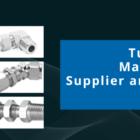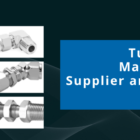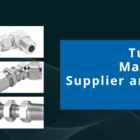What are Pipe Fittings?
Pipe fittings, sometimes referred to as pipe connectors, connect two pipes in a plumbing system to extend the run or reverse the direction of flow. They come in a range of diameters to fit the pipe they will join, and they are used to combine, divert, or reduce the flow of the water supply.
The dimensions of pipe fittings are important, and size guidelines must be maintained too. Some fittings are made with various-sized openings and act as a transition between different pipe sizes, while the majority have openings that are the same size on both ends.
Here Are A Few Things You Need To Know About Pipe Fittings
Every types of fittings has a specific function, and an effective installation depends on locating any weak points or improper fittings. The success of a pipe fitting ultimately depends on whatever fitting is selected for a certain application. All pipe fittings need to be compact, flexible, and dependable, but selecting the right one for the job is essential.
To assist you in selecting a pipe fittings for industrial applications, we will discuss typical types of fittings and how to use them for various needs.
A threaded fitting called a pipe fitting is used to construct various plumbing structures. Many types of pipe fittings are available in a variety of shapes and sizes. Examples include Plugs and Unions, Cap Pipe Fitting, Female Branch Tee, Female Elbow, Male Run Tee, and Female Run Tee. Regardless of its form, a pipe fitting is connected to tubes and pipes to divide equipment and close or seal a pipe.
A Leading Pipe Fittings Manufacturer in India, Mcneil Instruments specializes in the manufacture of high quality pipe fittings and other metal products. We provide a wide choice of pipe fittings that are specifically designed to satisfy the high standards of different industries, with an emphasis on excellent craftsmanship and precision engineering. Our reputation as a reliable partner in the manufacturing industry has been maintained by our commitment to innovation and client satisfaction.
Common Types of Pipe Fittings and Their Applications
In any plumbing fittings system, pipe fittings for industrial applications and tube fittings are frequently employed to create a straight connection between various components or sections. They are frequently called adapters since they may fit into different forms and sizes.
Fittings have several uses, including branching, rerouting, regulating, controlling, throttling, and more. They therefore exist in a variety of forms. Below is a discussion of some of the more popular ones along with their functions.
- Plugs and Unions: Plugs and Unions are used for closing pipe ends or connecting two pipe sections. Plugs seal an opening, while unions allow for easy disconnection for maintenance or repairs.
- Cap Pipe Fitting: This is essentially a plug specifically designed for capping the end of a pipe, offering a secure and leak-proof closure.
- Female Branch Tee: This fitting has a female threaded inlet on the main run and female threaded outlets on each branch, allowing you to connect a pipe to the main run and two additional pipes branching out at a 90-degree angle.
- Female Elbow: This fitting features a female threaded connection on each end, allowing you to change the direction of a pipe run by 90 degrees.
- Male Run Tee: This has a male threaded end that connects directly to a pipe and two female threaded outlets on each branch. It’s ideal for connecting pipes to a main run with female threaded connections.
- Female Run Tee: Similar to the male run tee, but with a female threaded end for connecting to a male threaded pipe. It offers two female threaded outlets on each branch for connecting additional pipes
Types of Pipe Fittings for Industrial Applications and Secure Connections
Various methods can be implemented to secure pipe joints, depending on the type of pipe, its characteristics, and the fittings for industrial applications utilized. Methods of connection include: Click-to-connect or push-to-fit fittings sometimes known as push-to-connect fittings. Installing these plumbing fittings for DIY plumbing projects is quick and simple. To grab and establish a watertight connection in low-pressure conditions, they are equipped with a unique O-ring and metal teeth. With PEX, PVC, and copper pipe, they can be utilized according to particular conditions.
- Threaded Fittings: For a snug fit, threaded pipe fittings can be twisted together. Female threaded pipes and fittings fit around male connectors, which have thread on the exterior, and have threading on the interior of the fitting. When we look at a bottle that has a twist-off lid, the threads on the bottle are male, but the lid is female.
- Sweat Fittings: When solder is melted, or “sweated,” around the joint of copper or brass fittings and pipes, a permanent, leak-free pipe junction is created.
- Slip Fittings: Liquid cement that dries quickly and primer is used to attach smooth-walled plastic pipes and fittings that slide together with ease.
- Compression Fittings: These fittings use pressure to force pipe segments together for a tight intersection. They also contain a threaded body, nut, and sleeve known as a “ferrule.”
- Flare Fittings: Once the pipe has been ‘flared’ using a specific tool, a flare nut and the cone-shaped fitting connect with the pipe and fitting. They are used for high water pressure and gas applications.
- Clamp Fittings: The fitting is inserted, and then a clamp is tightened around the pipe
- Crimp Fittings: After the fitting gets installed, a metal ring is securely pushed or crimped, around the pipe using a special tool.
Different Types of Pipe Fittings material Used for Making Pipe Fittings?
Fittings are built of a variety of materials to ensure that they are appropriate for every application.
- Steel: Steel fittings are durable and strong, and can resist high temperatures and pressures well. Carbon steel, stainless steel, and alloy steel are common types of steel used to make fittings.
- Copper: Copper fittings are malleable, so they can be shaped easily. In addition, they are corrosion-resistant and have good thermal conductivity. These features have made them popular in plumbing fittings.
- PVC: PVC fittings can be cheaper and lighter. Besides, they show good resistance to chemicals and corrosion.
- CPVC: CPVC fittings share the advantages of PVC fittings, but they are also suitable for higher temperatures.
- Brass: Brass fittings are not only visually appealing but also resist corrosion really well. They are mostly suitable for lower pressures.
- Ductile Iron: Ductile iron fittings are exceptionally strong and durable. That is why they are popular in industrial settings.
- ABS: ABS fittings are light and durable. Also, they can resist chemicals and low temperatures.
- HDPE: The main distinguishing feature of HDPE fittings is their excellent chemical resistance.
Different Types of Pipe Fittings Material with Characteristics and Industrial
the different types of pipe fittings materials and their typical uses:
| Material | Characteristics | Typical Uses |
|---|---|---|
| Carbon Steel | Strong, durable | Industrial applications |
| Stainless Steel | Corrosion-resistant | Food processing, chemical industries |
| Copper | Corrosion-resistant, easy to install | Water supply lines, plumbing |
| Brass | Corrosion-resistant | Plumbing, gas applications |
| PVC | Lightweight, chemical-resistant | Cold water plumbing, irrigation systems |
| CPVC | Higher temperature tolerance | Hot water lines, industrial applications |
| PEX | Flexible, scale-resistant | Residential plumbing (hot and cold water) |
| ABS | Durable, impact-resistant | Drain, waste, and vent pipes |
| Cast Iron | Strong, durable | Drainage systems, underground water mains |
| Ductile Iron | Flexible, shock-resistant | Water and sewer lines |
| Galvanized Steel | Rust-resistant due to zinc coating | Outdoor, industrial applications |
| Aluminum | Lightweight, corrosion-resistant | Specific industrial applications, lightweight needs |
| Bronze | Durable, corrosion-resistant | Marine applications, plumbing |
This table provides a quick reference to help choose the appropriate material for different piping needs based on their characteristics and typical applications.
Different industries where pipe fittings are used:
Given their diverse uses, pipe fittings are used in several sectors, including:
- Chemical/Petrochemical: Pipe fittings in this sector are crucial for transporting various chemicals and fluids safely and efficiently within processing plants and refineries.
- Municipal: Pipe fittings facilitate the distribution of water, sewage, and other utilities in municipal infrastructure projects, ensuring reliable and sustainable public services.
- Food, Beverage, and Dairy: In this industry, hygienic pipe fittings are essential for maintaining sanitary conditions during the processing and distribution of food and beverage products.
- Oil and Gas: Pipe fittings play a vital role in oil and gas operations by connecting pipelines, controlling flow, and ensuring the integrity of the infrastructure in exploration, production, and distribution processes.
- Power: Pipe fittings are used in power generation facilities to transport water, steam, and other fluids essential for operating turbines and other machinery.
- Semiconductor: In semiconductor manufacturing, specialized pipe fittings maintain the purity of process gases and chemicals critical for producing electronic components.
- Marine & Dredging: Pipe fittings are utilized in marine and dredging applications for constructing pipelines, drainage systems, and underwater infrastructure.
- Sanitation: Pipe fittings are integral to sanitation systems, facilitating the collection and disposal of sewage and wastewater to safeguard public health and the environment.
- Irrigation: Pipe fittings support irrigation systems by connecting pipes, controlling water flow, and distributing water to agricultural fields, gardens, and landscaping projects.
- Residential: Pipe fittings are essential components of residential plumbing systems, ensuring the efficient supply of water and the safe disposal of wastewater within homes and buildings.
- Road & Highway Construction: Pipe fittings are used in infrastructure projects for drainage systems, culverts, and utilities, supporting the construction and maintenance of roads and highways.
- Ventilation: Pipe fittings aid in ventilation systems by connecting ducts, controlling airflow, and removing stale air or fumes from enclosed spaces for better indoor air quality.
In all the above-mentioned industries pipes are used to transfer liquid, gas, slurries, and other solids and fluids from one area to another and accordingly different categories of pipe fittings are used.
People who are experts in the installation of pipe fittings in various industries:
The pipes are installed, repaired, and maintained by pipefitters. They study the design specifications required to construct suitable industrial piping assemblies, steam production, heating, and cooling systems. Additionally, they might work in a variety of contexts, such as homes, businesses, and industrial settings where pipe systems need to be installed.
- Plumber: The most common term for a pipefitting professional specializing in residential and commercial water and drainage systems.
- Pipefitter: The general term for skilled workers who install, repair, and maintain piping systems across various construction projects.
- Welder/Pipe Welder: Specializes in joining pipes using welding techniques, crucial for high-pressure applications.
- Steamfitter: Installs and maintains piping systems for steam distribution in buildings and industrial settings
- Process Pipefitter: Works in industries like oil & gas, chemical processing, and power generation, installing and maintaining piping systems for transporting various fluids and materials.
- Marine Pipefitter: Specializes in installing and maintaining piping systems on ships and offshore rigs, requiring expertise in corrosion-resistant materials and working in challenging marine environments.
- Fire Protection Pipefitter: Installs and maintains sprinkler systems and fire hydrant networks in buildings.
Selection Criteria for Pipe Fittings at Mcneil Instruments
Choosing the right pipe fittings involves considering several important factors to ensure compatibility and performance. Here’s a guide to help you select the appropriate fittings:
- Connection Types: Pipe fittings can feature various connection types. For instance, a fitting may have one end as female threaded and the other as male threaded, or one end as male slip and the other as threaded, particularly in plastic fittings. Ensure the fitting’s connection types match your specific requirements for a secure and leak-free connection.
- Materials of Construction: Typically, the material of the pipe fitting should match the material of the pipe it is being used with. However, fittings made from materials conforming to specific codes or standards may sometimes be used with different pipe materials. For example, stainless steel fittings may be used with carbon steel pipes depending on the application.
- Flow Considerations: To maintain consistent flow, the ends of pipe fittings should be slightly larger than the pipe to avoid narrowing the inner diameter (ID) of the pipe. This helps in smooth, uninterrupted flow and reduces the risk of blockages.
- Type of Fitting: Pipe fittings are available in various types, such as threaded or slip, and male or female configurations. Choose the type that best suits your piping system and application needs.
- Size: For accurate fitting, measure the size of the pipe fittings correctly. Male threaded fittings are measured to the outside diameter (OD), while female fittings are measured to the inside diameter (ID) of the inlet.
- Thickness: Pipe fittings come in different thicknesses or “schedules,” similar to pipes. Ensure that the thickness of the fitting matches the schedule of the pipe for a proper fit and performance.
- Design: Fittings are designed to handle specific types of fluids, gases, chemicals, or conditions. Select a fitting design that aligns with the requirements of the fluid or environment it will be used in.
- Standards and Codes: Adhere to industry standards and codes when selecting pipe fittings. Organizations like ASTM, ASME, and BSP set these standards, which dictate the quality and usage of fittings. Ensure the fittings comply with relevant standards to guarantee reliability and safety.
At Mcneil Instruments, we offer a wide range of pipe fittings designed to meet these criteria, ensuring optimal performance and compatibility for your industrial applications.
Conclusion
The world’s infrastructure depends on a massive network of pipes to carry essential liquids, and the lesser-known heroes of this network are pipe fittings. Pipefitters, who range from the friendly plumber servicing your kitchen sink to the experts in industrial environments, make sure these connections are safe, effective, and appropriate for the intended use. Making informed judgments for your own plumbing needs is made possible by having a thorough understanding of the many types of pipe fittings, the materials they’re constructed of, and their numerous functions. Proper pipe fitting selection and installation are essential for a safe, functioning, and long-lasting system, whether one is navigating the complexity of industrial pipes or simply wants to ensure a leak-proof connection at home.






